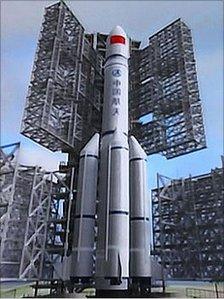China considers big rocket power
- Published

Engines on China's Long March-5 will develop 120 tonnes of thrust
Chinese engineers are considering a new super-powerful engine for the next generation of space rockets, say officials.
According to Li Tongyu, general manager of the marketing department at the China Academy of Launch Vehicle Technology (CALT), engineers are currently studying a rocket engine capable of generating thrust of 600 tonnes.
If China succeeds in the development of such power, it would increase the nation's capabilities in space by orders of magnitude.
For comparison, China is currently well in the development of its most powerful rocket to date - Long March-5 - that would sport engines with the thrust of 120 tonnes.
"Rockets (with 600-tonne thrust engines) would only be justified for things like sending humans to the Moon, if such projects are approved," Li Tongyu told BBC News.
In March, the official China Daily newspaper disclosed that CALT was studying a super-heavy launch vehicle, which could be used to mount lunar expeditions.
At the time, the newspaper quoted CALT Vice President Liang Xiaohong as saying that the total lift-off thrust of the future heavy launcher would be 3,000 tonnes.
'Grander scale'
To develop such thrust, the first stage of the proposed rocket would need five 600-tonne engines, possibly distributed between one central stage and four strap-on boosters.

China hopes to carry out its first LM-5 test launch in 2014
The rocket's architecture would thus be similar to the one adopted for the Long March-5 rocket, but at a considerably grander scale.
Although the expected payload of the future heavy lifter had not been disclosed, available details allow placing it close to the same category with that of the Saturn-5 rocket, which carried US astronauts to the Moon.
In the meantime, the development of the Long March-5 rocket was proceeding well toward its first test launch, currently expected in 2014, Li Tongyu said.
The vehicle's first stage engine had already accumulated more than 10,000 seconds of firing during tests - an important milestone on the way to its certification for real missions.
A full-scale prototype of the Long March 5 rocket would be ready for testing in 2012 and a year later, test firing of fully assembled rocket stages would be conducted.
When operational, Long March-5 is expected to deliver up to 25 tonnes of payload, including space station modules to the low Earth orbit, and up to 14 tonnes to the so-called geostationary transfer orbit, where most communications satellites are released after launch.
At the UK's Farnborough airshow, CALT demonstrated computer-generation videos, showcasing impressive new assembly and launch infrastructure of the Long March-5 rocket.
Newly built facilities will feature a sprawling campus not far from Chinese capital Beijing, where the rocket would be assembled.
The rocket stages would then be shipped to the launch site in the very south of China, where it could take advantage of the Earth rotation to maximise its cargo capabilities.
Along with Earth-orbiting satellites, the Long March-5 is expected to carry Chinese spacecraft into deep space, including unmanned missions to return soil samples from the Moon.